If you like growing hot peppers then you know you can be inundated with more peppers than you can use right away. Maybe it’s time to consider making your own chili powder. Three simple steps: grow hot peppers, dry the peppers, and grind them into powder. Before you go running to the garden, though, you may want to take into account a few things before you take the plunge.
(You will find ads and affiliate links that I may earn commissions from if you make a purchase. It will add no cost to your purchase and it helps support this website in a small way. Every little bit helps! Thank you for your support.)
Simple With Precautions
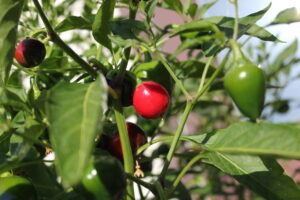
Before you make your own chili powder, take a couple of precautions. First, make sure you have latex or nitrile gloves to use. The capsaicin in hot peppers can cause some painful burns if you handle them with your bare hands. Washing your hands doesn’t always work well so please use gloves. Yes, I speak from experience. After cutting up about a pound of hot peppers, I ended up with mild chemical burns that felt like a bad sunburn. Luckily the pain calmed down within a couple of hours. Take a lesson from my negligence: wear gloves!


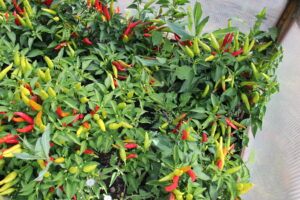
Second, decide where you will dry the peppers—will it be in a dehydrator designed for the purpose or will it be in your oven? Drying peppers produces some very pungent odors that can be overwhelming especially for someone with any kind of breathing problems. Consider keeping the drying process outdoors. Drying them inside is certainly an option, but consider keeping the batches small (perhaps half a tray) and run your exhaust fan at all times to vent to the outdoors. I dried two full trays in my oven simultaneously and it was difficult for my oven fan to stay ahead of the spicy aroma that filled the kitchen, then the whole upstairs, then wafted down the stairs to my office. I opened the windows and doors and finished drying the peppers in short bursts of about 15 minutes at a time. It took longer to complete the process but at least the experience was tolerable.
What Part of the Peppers to Include
All the peppers need to be cut up in pieces. What size pieces are up to you. I grow about five different varieties and the mature peppers are of all different sizes. Optimally, the pieces should be about the same size so that they all dry at the same rate. I would rather not worry about the size of the pepper chunks, so instead I’ll check them more often, removing the smaller pieces before the larger ones.
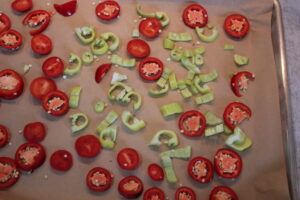
A lot of the capsaicin in the peppers resides in the seeds and the white flesh of the pepper. You’ll have to choose whether to include those parts of the pepper or not. Do you want the resulting chili powder to be as hot as possible? Then leave the white pithy membrane and the seeds. You may want to at least consider removing the seeds because they are more difficult to grind up for the final product.
You certainly have a few choices. My chili powder includes pretty much everything. I cut off the stem end, clean off the blossom end, slice them down the middle, and place them on the drying tray on parchment paper to go directly into my oven. If you are using a dehydrator, you’ll want to adjust the settings according to the instructions for the brand you have, place the peppers directly on the drying tray, and set it for the recommended time. I would suggest placing your dehydrator outdoors in a safe place (perhaps under a covered porch).
What Is Dry Enough?
Dry enough is crunchy and hard. There should be no flex in the pieces of pepper that lay shriveled on the drying trays. Let them cool completely before testing them because they may still show a little flex when they are still warm. They should break and crumble when they are dry enough.
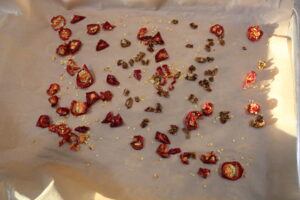
Take care to dry them just enough by testing them often. Low temperatures prevent scorching but I hate to take chances with overdoing the drying process. Figure for shorter times than specified on your dehydrator and then check the smaller pieces. Let them cool and remove the pieces that crack instead of bending. Place those pieces in a container with a lid or start grinding them up right away. Then reset the dehydrator or oven to keep going.
The lowest my oven will go is 170 degrees Fahrenheit. This is fairly high for drying peppers so I’ll only dry them for about 30 minutes at a time, let them cool, check them for doneness, remove the crunchy ones, and then put the rest back in the oven. This way it will take me a couple of days to dry a tray of peppers but I don’t mind being careful not to overdo it. At 170 degrees, it is much easier to scorch the peppers than it is in a dehydrator that can be set as low as 100 degrees F (use the settings for your specific dehydrator).
The Last Grind
There are a few ways to grind your dried chili peppers. My recommendation would be to grind them in batches in a coffee grinder. These small, inexpensive grinders are made to create the right consistency. If you have small batches, it will make it difficult for a food processor or blender to make it powdery enough.

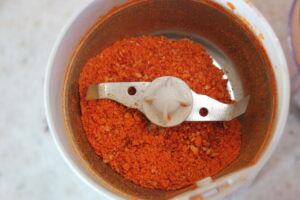
I also find that coffee grinders are good at keeping the ground up chili powder where it belongs. Having chili powder tossed into the air can be another safety hazard you don’t want to deal with. I haven’t been unfortunate enough to deal with a mishap that sends you scurrying out the door, but I do know people who have. It is not fun. And think about the clean up involved if you have chili powder all over your cabinets and counters.
To prevent this kind of chili disaster, use a small coffee grinder, and leave the lid on until all the powder has settled to the bottom. In other words, take your time. Be patient. Gently empty the contents of the coffee grinder into a glass jar. Then start on the next batch to grind. Slow and steady is the motto for the grinding task.
I mix all of my five varieties of hot peppers and place them in one glass jar or tightly sealed plastic container with a date. Out of about 40 plants of hot peppers, I ended up with approximately 8 ounces of chili powder and several bags of frozen peppers. This should be enough to last us all winter. Hooray!
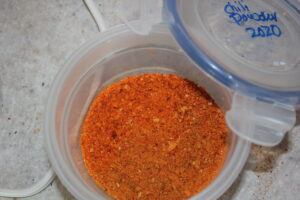
Spread the Joy
Making your own chili powder is something that every gardener who loves a bit of heat in their peppers should try doing at least once. Small jars make great gifts too. I have gardening friends who use small jars to give as thank you gifts throughout the year. What a great idea. Know someone who loves a lot of spicy flavor? Some homemade chili powder may be the perfect gift. Add a fun recipe to hang around the jar for that added something special.
Comment below with your thoughts. What kinds of peppers do you prefer? Will you try making chili powder for the first time this year? Let us know.






This is perfect! We just picked some peppers from our garden and I was thinking of making some chili powder.
Good luck, Caitlin. I’m glad the post came at the right time for you!
Kerry
How cool! I want to plant peppers now. ?
You should do that, Ashley!
I appreciate you checking out the article!
Kerry
My brother grows a ton of chili peppers, I’m going to send him this article! He makes hot sauce but I’ve never heard him mention chili powder.
Thank you, Samantha! I’m making hot sauce this year as well but mostly using only one variety of pepper for that.
I’d love to hear how your brother does his hot sauce. There are so many different recipes for it.
Thanks!
Kerry aka The Negligent Gardener